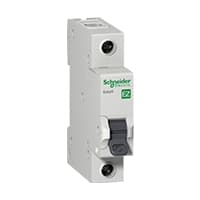MCCB wiring connection diagram:
This diagram shows how to make an MCCB wiring connection diagram. In this circuit, we use an FP MCCB ( Four Pole Miniature Circuit Breaker ), and some SP MCBs ( Single Pole Miniature Circuit Breaker ). This circuit is very simple and easy to make. If you want to know more details about this circuit please check our youtube video below the post and stay with us for more updates.
Advertisements
Components needed For this Project:
You can get the components from any of the sites below:
*Please note: These are affiliate links. I may make a commission if you buy the components through these links. I would appreciate your support in this way!
Advertisements
Components used to make the MCCB wiring connection:
In single-pole MCB, Switching and protection are Affected in only one Phase. Single phase supply to break the phase only. A single Pole breaker is Typically used with 120-volt Circuits, and a 6-20 amps Miniature Circuit Breaker. They are constructed with one Line Wire and one Neutral wire. A Single Pole switch is the most basic General-Purpose switch that you use to Control a light or another device from one location. These Switches have 2 Brass-Colored screw Terminals Connected to the hot Power source wires. Pole refers to the number of Circuits Controlled by the Switch SP Switches Control only one Switch Electrical Circuit.
02. FP MCB:
4 pole MCB for 4-Wires Connections, the one additional 4th pole for Neutral Wire Connection so that between Neutral and any of the other three will supply. In 4-Pole MCB the Neutral Pole is also having Protective release as in the Phase Poles connection. 3 Phase Supply with Neutral. TPN means triple pole TP + Neutral which is 3 - phases and Neutral. but the Protection is given for 3 Phases only and in 4 poles MCB Protection is given to all 3-Phases as well as Neutral. In the case of a 4-pole MCB. A Purpose is not to protect the Neutral but it is rather to Isolate the Neutral.
Thank You for visiting the website. Keep visiting for more Updates.
Frequently asked questions
It relies on the bimetallic mechanism which, when heated by an overcurrent, bends to disconnect the circuit diagram. The magnetic mechanism was primarily a solenoid and was meant to provide an instantaneous (or almost instantaneous) trip for more serious faults like short circuit diagrams.
First, we need to connect the MCCB with the power source, then connect the magnetic contactor, connect the transformer, connect the start switch and stop switch, and then connect the overload and motor with the circuit diagram breaker.
MCB was an automatic switch that opened when excessive current flowed through the circuit diagram. It should be reclosed without any manual replacement. In the case of a fuse, once it has been operated, it must be replaced and rewired, depending on the type of the MCB.
A molded case circuit diagram breaker, or MCCB, is a safety device used to protect an electrical circuit diagram from overload or a short circuit diagram. It works by automatically cutting the flow off the power supply when a fault or overcurrent situation arises, thus preventing any damage to the electrical of system.
Mcb deploys to save the system, phase comes first to connect to the system, while neutral is the returned path provided for cloud the circuit and is grounded at ~0V potential after the system or other end. When a fault occurs the fault voltage supplied to phase and mcb provided get tripped and the system is saved.
Read more Single Phase Wiring
What is a kilowatt-hour (kWh) | kwh formula | What does kwh mean
Introduction to Electrical Units and CircuitskW and kWh on your electricity bill As your home uses electricity during...
What is the Difference Between kVA | What does KVA mean | kVA formula
Difference Between KVA ExplainedWhat does KVA Mean? There are technical terms aplenty when it comes to generators, and...
Power Factor | Power Unit | Energy | Electricity Unit
Power factor definition | Calculating Power FactorPower Factor Values In a purely resistive circuit, the power factor...



0 Comments